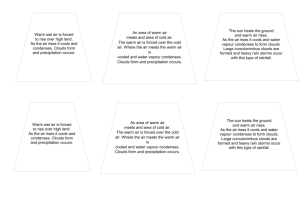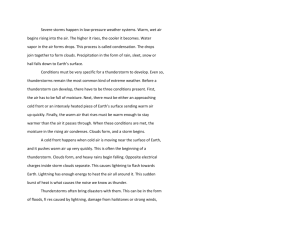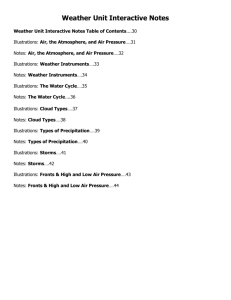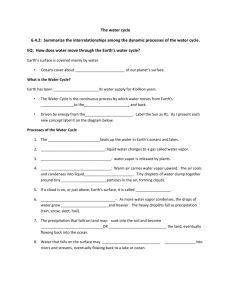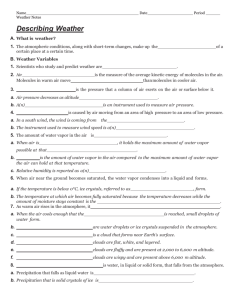Atmosphere Unit Review answers
advertisement
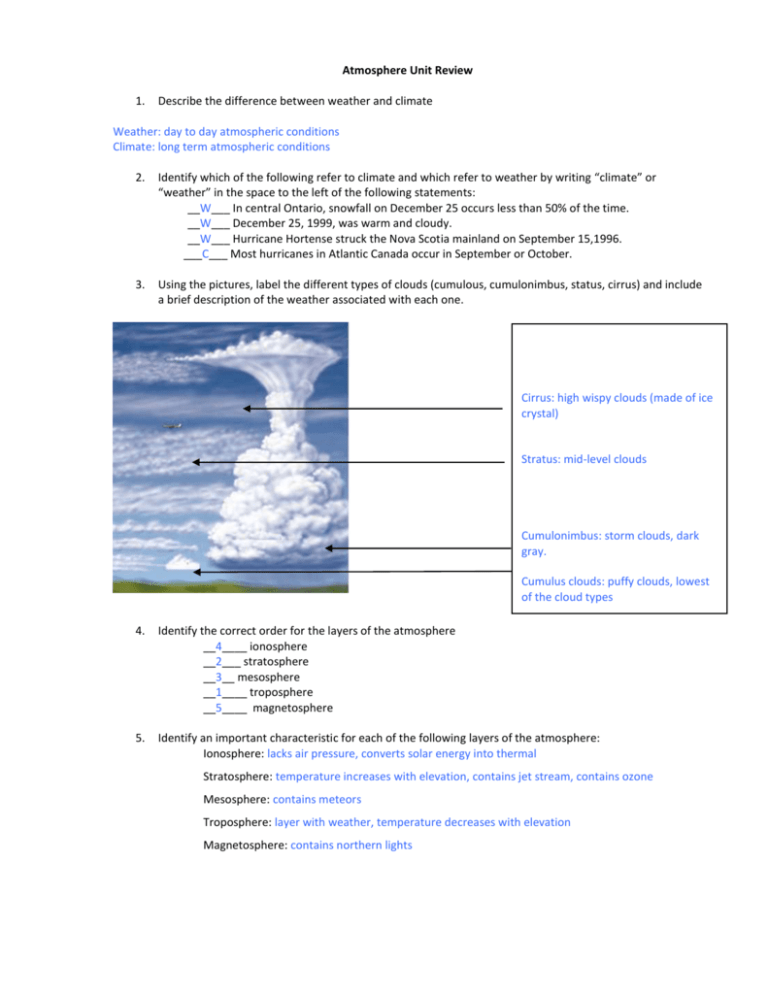
Atmosphere Unit Review 1. Describe the difference between weather and climate Weather: day to day atmospheric conditions Climate: long term atmospheric conditions 2. Identify which of the following refer to climate and which refer to weather by writing “climate” or “weather” in the space to the left of the following statements: __W___ In central Ontario, snowfall on December 25 occurs less than 50% of the time. __W___ December 25, 1999, was warm and cloudy. __W___ Hurricane Hortense struck the Nova Scotia mainland on September 15,1996. ___C___ Most hurricanes in Atlantic Canada occur in September or October. 3. Using the pictures, label the different types of clouds (cumulous, cumulonimbus, status, cirrus) and include a brief description of the weather associated with each one. Cirrus: high wispy clouds (made of ice crystal) Stratus: mid-level clouds Cumulonimbus: storm clouds, dark gray. Cumulus clouds: puffy clouds, lowest of the cloud types 4. Identify the correct order for the layers of the atmosphere __4____ ionosphere __2___ stratosphere __3__ mesosphere __1____ troposphere __5____ magnetosphere 5. Identify an important characteristic for each of the following layers of the atmosphere: Ionosphere: lacks air pressure, converts solar energy into thermal Stratosphere: temperature increases with elevation, contains jet stream, contains ozone Mesosphere: contains meteors Troposphere: layer with weather, temperature decreases with elevation Magnetosphere: contains northern lights 6. 7. For each of the following cities, identify one climate factor that influences the climate in that region and explain: a. Halifax, NS: Proximity to Water – Halifax is next to the Atlantic Ocean. This will create a maritime climate (wet). As well, the Gulf Stream flows north along the coastline warming the air above. b. Windsor, ON: latitude: Windsor is the southern most city in Canada. Therefore it is closer to the equator and will be receiving more sunlight. This will increase the temperature in this region since the solar energy is concentrated in a smaller area. c. Yellowknife, NWT: latitude: Yellowknife is in the northern part of Canada. As the sunlight spreads over the top of the globe, the solar energy is spread over a larger region. This prevents the particles from Many New Yorkers flock to Central Park on days with excessive heat. Explain why they might do this. - lakes in the park provide a source of evaporation and moderate the land next to the lake. The lakes take a long time to heat up. Until they heat up, the lakes will blow cool air onto the land. - Transpiration in the trees: the evaporation process will help to cool the area. - Trees and grass are a poor heat sink and do not absorb heat very well. This keeps the area cool. - Trees provide shade and block the sunlight. 8. For each statement below, write in the name of the atmospheric layer each describes: Where most of our weather occurs ___troposphere__________ Contains most of the ozone layer ___stratosphere__________ Contains ions, and is where the northern lights occur __magnetosphere____________ The coldest temperatures in the atmosphere _____mesosphere________________ Can be called "space" because there are very few particles ____magnetopause_______ 9. Not all places receive the same amount of precipitation. a. In general, which cities receive more? Cities near coastlines b. Why is this the case? Explain. Water evaporates and the water vapour is added to the atmosphere. The air mass is blown onto the land. As the air warms up with solar radiation, the air mass rises. As the air mass rises, it condenses and forms water droplets. When the droplets are large enough, gravity pulls the water droplets down (precipitation). 10. Using your knowledge on types of precipitation, explain why it rains so often in Ontario during the spring. Warm air masses from the south move northward during the spring. Cold air masses from the north are pushed southwards during the winter and early spring. The collision of these two air masses causes the precipitation. As the two air masses collide, the warm air mass is pushed up and over the cold air mass. As the warm air mass rises, the air cools and condenses. This causes water droplets. When the droplets are large enough, gravity pulls the water droplets down (precipitation). The larger the temperature differences between the two air masses, the bigger the storm. 11. Describe the impact the warm Pacific Current and the Rocky Mountains have on the climate in British Columbia. The warm Pacific current warms the air above the ocean water. The mid-latitude blows this warm air onto the land causing the region to be warmer. As the air mass reaches the Rocky Mountains, the air mass is pushed up the mountains. As the air travels up the mountains, the air condenses and cools. This will form water droplets. With gravity, these water droplets are pulled down as precipitation. 12. Complete the following chart: Tropical Storm Tornado - over oceans - - over land - commonly over the United States - warm air rises creating a low pressure system - the winds start to rotate - as warm air rises, the storm intensifies - water droplets are formed as the air rises. This creates rain. - The rotating warm air rises, causing updrafts. These updrafts, increases the speed of rotations Location Formation -Cool air from the jet stream adds energy from the top of the storm -Water condenses into droplets and form a funnel cloud. This cloud grows. When it touches the ground, it is known as a tornado Scale Monitoring/ Prediction Saffir-Simpson scale Fujita - satellite images - airplanes - satellite - balloon sensors - Doppler radar 13. Place a T for true or F for false beside each of the statements. If it is false, correct the statement. a. Wind direction is reported as the direction from which the wind is blowing. True b. Clouds associated with stormy weather are classified as nimbus clouds. True c. Jet streams are fast moving ocean currents. False d. The Earth's atmosphere is mostly made up of oxygen gas. False e. Any object or material that absorbs energy and becomes warmer is called a heat sink. True f. Carbon dioxide is a greenhouse gas. True g. Low-pressure systems are associated with clear, dry weather. True h. Air tends to fall at the equator. False i. As you move further from the equator, the radiation that strikes the Earth’s surface is more spread out. True

